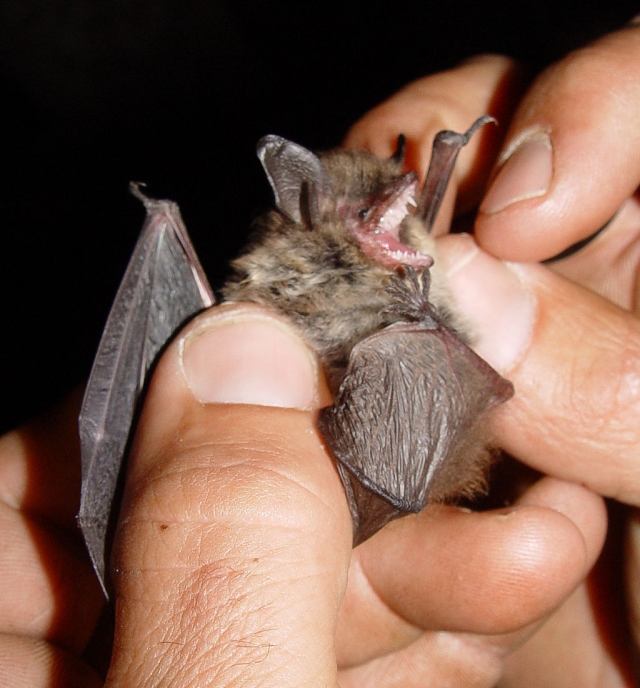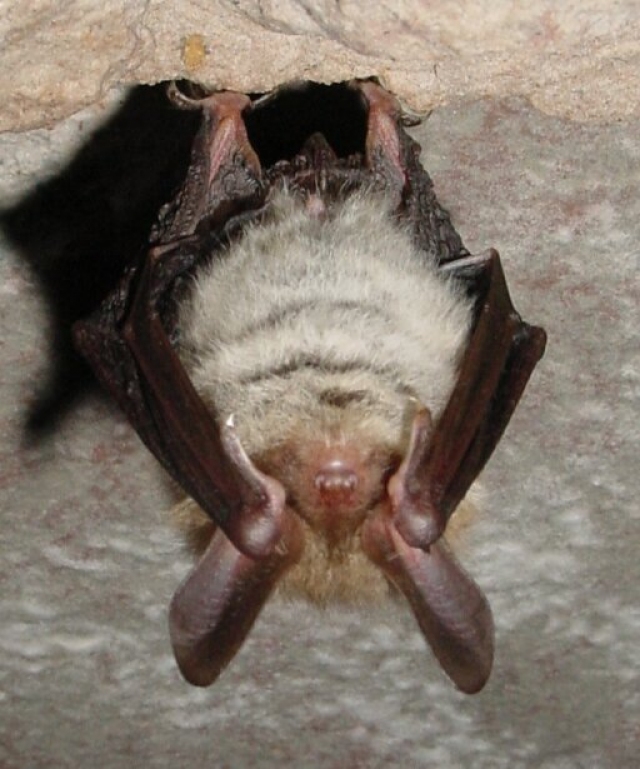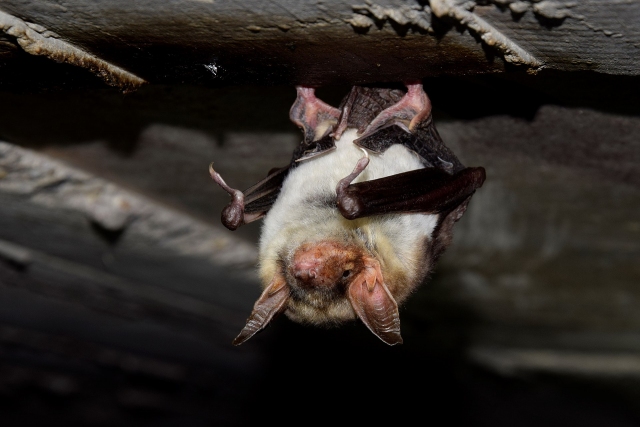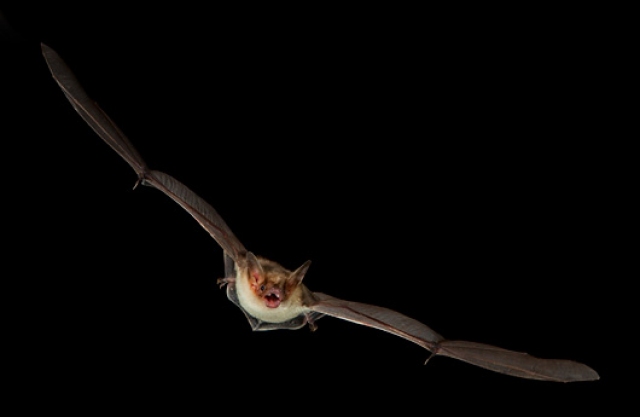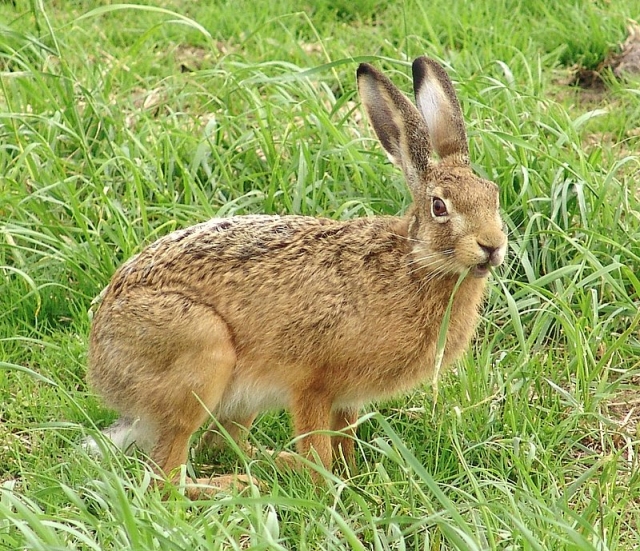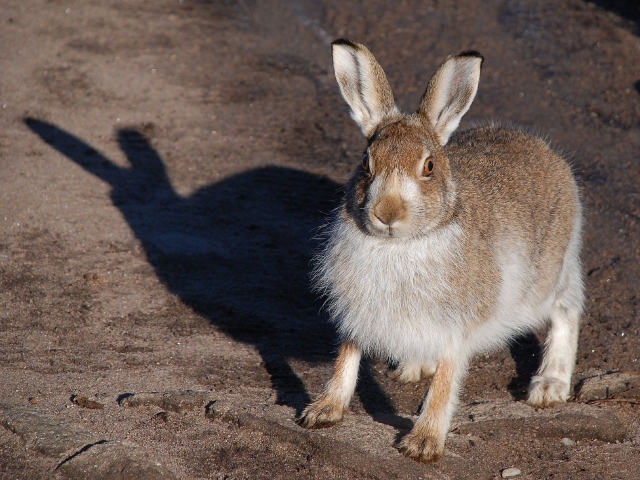Florian Heigl
Alpine long-eared bat
Description
The species is slightly larger than the common brown long-eared bat, which is also common in Central Europe. The snout-vent length is 46-55 mm, the forearm length 37-46 mm, the tail length 41-53 mm and the ear length 34-38 mm. The animals weight 6-10 g. The upperpart is light grey, light reddish brown or light brown-grey depending on the distribution, the underpart is yellowish white or greyish white to almost white. The head is predominantly whitish, a dark face marking extends from the corners of the mouth to in front of the eyes. Obviously characteristic for the species is a triangular, grey, hard field at the tip of the lower jaw.
Habitat
Information on the habitat of the species is scarce. Like the other species of long-eared bats, it is likely to feed on insects and spiders collected from vegetation or the ground. The nursery roosts are often located in churches and contain up to 50 individuals. Winter habitats have not been found so far.
The text is a translation of an excerpt from Wikipedia (https://de.wikipedia.org/wiki/Alpen-Langohr). On wikipedia the text is available under a „Creative Commons Attribution/Share Alike“ licence, Status: 17 August 2021
Brandt's bat
Description
The Brandt's bat is a rather small bat species. Its snout-vent length is only about four to five cm, its wingspan is between 19 and 20 cm, and its forearm length is between 32 and 39 mm. An adult Brandt's bat weights between 4 and 10 g. The rather long fur is dark brown.
The rather long coat has dark brown fur roots, on the upperpart it is golden brown. The belly is grey, sometimes with a yellowish tinge. The ears are moderately long, the tragus is narrow, pointed and about half as long as the ear. The ears, snout and patagium are light brown, the base of the inner auricle and the tragus usually lighter.
Habitat
The Brandt's bat is strongly bound to forests and often to water bodies. It lives in mixed forest, deciduous forest and sometimes in coniferous forest. It is less common than the whiskered bat in the vicinity of human settlements. In summer it usually hibernates in tree hollows, but also in buildings and nest boxes, in winter in caves, tunnels, mines and cellars.
Brandt's bat are crepuscular. Fast and agile in flight, they hunt small non-aquatic insects at low altitudes near water bodies.
The text is a translation of an excerpt from Wikipedia (https://de.wikipedia.org/wiki/Große_Bartfledermaus). On wikipedia the text is available under a „Creative Commons Attribution/Share Alike“ licence. Status: 17 August 2021
Whiskered bat
Description
With a snout-vent length of about four cm, a wingspan of about 20 cm and a forearm length of 32 to 36.5 mm, the whiskered bat is one of the smallest European myotis species. Adults weight four to seven g. Whiskered bats are darkly coloured, especially on the face, the fur is nut-brown to grey-brown on the upperpart, the underparts are grey. The ears, snout and patagium are blackish brown. Overall, the whiskered bat looks very similar to the Brandt's bat, the Alcathoe's bat and the steppe whiskered bat.
Habitat
The whiskered bat is not as dependent on water bodies and forests as its larger relative, the Brandt's bat. It also occurs in semi-open to open landscapes as well as in villages. Summer habitats are found both in buildings and in other crevices, such as behind tree bark. Winter habitats are mainly in caves, tunnels and cellars. The whiskered bat usually hunts structurally at forest edges or along other vegetation. More open landscapes such as orchards or water bodies are also used for hunting.
The text is a translation of an excerpt from Wikipedia (https://de.wikipedia.org/wiki/Kleine_Bartfledermaus). On wikipedia the text is available under a „Creative Commons Attribution/Share Alike“ licence. Status: 18 August 2021
Bechstein's bat
Description
The relatively long and broad ears of the Bechstein's bat have a pointed ear cover, which is typical for all species of mouse ears (Myotis). They have a wingspan of between 25 and 29 cm and weigh between 7 and 14 g.
Habitat
This forest-dwelling species prefers tree hollows as summer habitats. As a substitute, however, bird nesting boxes are also accepted time and again. However, bird nesting boxes are not a sufficient alternative, as the Bechstein's bat frequently changes its habitat and is therefore dependent on a habitat network, such as exists in a cave-rich forest with many old trees and a corresponding proportion of deadwood.
Like other bats, the Bechstein's bat feeds on small insects such as flies, midges and moths. Since this species has mastered shaking flight and can perceive the crawling sounds of its prey, it also picks up, for example, spiders and caterpillars directly from the vegetation. Its hunting grounds include the forest, especially the insect-rich forest layers close to the ground.
The text is a translation of an excerpt from Wikipedia (https://de.wikipedia.org/wiki/Bechsteinfledermaus). On wikipedia the text is available under a „Creative Commons Attribution/Share Alike“ licence. Status: 18 August 2021
Greater mouse-eared bat
Description
With a snout-vent length between 6.7 and 8.4 cm and a wingspan between 35 and 43 cm, the greater mouse-eared bat is the largest European species of Myotis. An adult weighs between 28 and 40 g. The greater mouse-eared bat has a very short and broad snout, the ears are long and wide. The short fur of adults is blackish-brown at the hair roots and light brownish-grey on the upperpart. The belly is white-grey, the neck sometimes slightly yellowish. Juveniles are more grey than brownish. The snout, ears and wings are grey-brown. In contrast to the adult greater mouse-eared bat, the lesser mouse-eared bat is dark grey in colour, and its body measurements are usually smaller than those of the greater mouse-eared bat. The number of ear folds (7-8 in the greater mouse-eared bat, 5-6 in the lesser mouse-eared) is also a distinguishing feature.
Habitat
The habitat of the greater mouse-eared bat is mainly open terrain, such as meadows, fields and open woodland, but also human settlements. Summer habitats are in roof trusses and church towers, also in bridges. The animals hang freely here.
When foraging, they like to fly between trees at low (1-2 m above the ground) and medium altitudes, listening to the rustling sounds of prey running on the ground (passive detection). The sense of smell probably also plays a greater role in finding prey, with echolocation taking a back seat. The animals are also capable of so-called shaking flight for a short period of time. 4 to 17 km can lie between the roost and the hunting habitat. The main food is ground-dwelling arthropods, especially large ground beetles (Carabus), arachnids (Arachnida) and centipedes (Chilopoda).
The text is a translation of an excerpt from Wikipedia (https://de.wikipedia.org/wiki/Großes_Mausohr). On wikipedia the text is available under a „Creative Commons Attribution/Share Alike“ licence. Status: 18 August 2021
Lesser mouse-eared bat
Description
The lesser mouse-eared bat is very similar to the somewhat larger greater mouse-eared bat. It reaches a snout-vent length of 62 to 71 (rarely from 54, or up to 76) mm and a weight of 15 to 28 g. The wingspan is 380 to 400 mm and the condylobasal length 17.2 to 18.5 mm. The wingspan is 380 to 400 mm, the condylobasal length 17.2 to 18.5 mm. The tail is 53 to 59 (maximum 60) mm long, the ears 19.8 to 23.5 (maximum 26) mm and the forearm 52.5 to 59 (maximum 62.5) mm. The ears are narrow and shorter than those of the greater mouse-eared bat. The anterior edge of the ears is not so strongly curved backwards and the ears taper more pointedly. The tragus is narrower at the base, lanceolate and becomes almost half as long as the ear. The outer edge of the ear has 5 to 6 transverse folds. The snout is narrower and more pointed compared to the greater long-eared bat, making it appear longer. The coat is short and the base of the fur is dark grey. The upperpart is grey with a brownish tinge, while the underpart is greyish white. Ears, snout and patagium are light grey-brown. The tragus is pale yellowish white. The patagium of the arms attaches to the base of the toes. The spur is about half as long as the uropatagium and has a narrow skin margin.
Habitat
The lesser mouse-eared bat is found in warmth-favoured areas in loose stands of trees and bushes, parks, karst areas, but also in towns and villages. The species has been recorded up to altitudes of 1000 m.
They hunt in the dark or late twilight. Their flight is steady and slow, they are more agile in confined spaces than the greater mouse-eared bat. Food is probably also taken from the ground. Prey are beetles and moths.
The text is a translation of an excerpt from Wikipedia (https://de.wikipedia.org/wiki/Kleines_Mausohr). On wikipedia the text is available under a „Creative Commons Attribution/Share Alike“ licence. Status: 18 August 2021
Geoffroy's bat
Description
The Geoffroy's bat is a medium-sized species and reaches a snout-vent length of about 41 to 53 mm with a wingspan of 22 to 24.5 cm and a weight of 7 to 15 g. The tail reaches a length of 38 to 46 mm. The tail reaches a length of 38 to 46 mm. The long and woolly dorsal fur is tricoloured with a grey base, straw-yellow centre and rust-brown to foxy-red tips. The ventral side is yellowish-grey and the snout is reddish-brown. Juveniles of the Geoffroy's bat are distinctly darker in colour than adults and have a smoky grey to brown-grey dorsal coat. The ears of the species are dark grey-brown and medium-sized, with an almost right-angled indentation on the outer edge of the upper third and six to seven pronounced transverse folds. The outer side is covered with numerous conspicuous papillae. The tragus is lanceolate and notched on the outer margin, almost reaching the indentation of the outer margin in height.
The patagium is also greyish-brown in colour. The forearm is 36 to 41 mm long and the wings are relatively broad. The hand flight skin (plagiopatagium) attaches to the toe root of the relatively small feet. The tail flight skin (uropatagium) has a straight calcar that reaches about half the length of the uropatagium. The bat got its name from sparse fine hairs on the dorsal side of the uropatagium, which overhang the free edge of the uropatagium.
Habitat
Summer habitats are often very bright compared to those of other species, in attics they prefer temperatures between 25 and 30 degrees Celsius and hang freely from roof battens or the ridge.
They hunt their prey in flight like other bats, but also prey on caterpillars. The flight out to hunt begins about 40 to 45 minutes after sunset. The hunting grounds are usually close to the hunting grounds at about 500 m, and are reached via flight paths along hedges or paths. The bat hunts close to the ground at a height of one to five m and over water surfaces at a height of about two m. In the area of hedges and vegetation edges it flies slowly and collects prey, otherwise it is an agile flyer. In addition, Geoffroy's bats also like to hunt in livestock sheds, where they collect insects and spiders from walls and ceilings in pendulum flight.
The text is a translation of an excerpt from Wikipedia (https://de.wikipedia.org/wiki/Wimperfledermaus). On wikipedia the text is available under a „Creative Commons Attribution/Share Alike“ licence. Status: 18 August 2021
Common bent-wing bat
Description
The common bent-wing bat is a medium-sized bat with a snout length of 5.00 to 6.25 cm, a tail length of 5.6 to 6.4 cm, a wingspan of 30 to 34 cm and a weight of 9 to 16 g. The dorsal fur is grey to greyish-brown, sometimes with a purple shimmer. The dorsal coat is grey to grey-brown, sometimes with a lilac tinge, the ventral side is lighter grey. On the head, the coat is short and protruding. The snout, the ears and the patagiums are greyish brown, the tragus yellowish white.
The snout is relatively short and blunt and the forehead arched, the ears are small and triangular in relation to the head, they do not protrude above the crown of the head. The ears have four to five transverse folds and a short tragus, which is curved inwards and rounded at the tip.
The species got its name from the long, dark brown wings that narrow towards the back. The second limb of the third finger is about three times as long as the first. The arm patagium attaches to the heel of the feet, which are comparatively long.
Habitat
It is a cavern species that occurs in the plains as well as in the mountains and in karst areas. Caves, cellars and tunnels with temperatures between 7 and 12 °C are mainly inhabited as summer and winter quarters. They also use roosts on and in buildings. The bats hang freely from walls and ceilings, sometimes in larger groups.
The text is a translation of an excerpt from Wikipedia (https://de.wikipedia.org/wiki/Langflügelfledermaus). On wikipedia the text is available under a „Creative Commons Attribution/Share Alike“ licence. Status: 18 August 2021
European hare
Description
Together with the Alpine hare, the European brown hare is the largest hare in Europe. The snout-vent length is 55 to 68 cm, the tail length 75 to 140 mm, the length of the hind feet 124 to 185 mm and the length of the ears 100 to 140 mm. Adult animals weigh 3.5 to about 5.0 kg.
The coat is long, the outer fur is curved in most of the distribution area. The woolly hairs have a white base. The back is variably coloured and can be yellowish grey, ochre-brown or brown-red with yellow shading and speckled with black. The back is darker than the sides of the body and the face. The flanks are more rusty yellow or reddish brown. The head and neck, the chest and the legs are light brown, the belly is creamy white. The ears are pale grey and show a black, roughly triangular spot at the tip. The tail is black on the underpart and white underneath. In winter coat, the sides of the head including the base of the ears are whiter and the hips more grey.
Habitat
The relatively warmth-loving species inhabits open and semi-open landscapes such as sparse forests, steppes, dunes and the agricultural landscape with hedges, bushes or adjoining forests from sea level up to 2500 m.
The text is a translation of an excerpt from Wikipedia (https://de.wikipedia.org/wiki/Feldhase). On wikipedia the text is available under a „Creative Commons Attribution/Share Alike“ licence. Status: 18 August 2021
Alpine hare
Description
With an average weight of about three kg and a length of just under 40 to 60 cm, it is slightly smaller than the European hare. Its change of coat from a grey-brown summer coat to a white winter coat is well known. However, this depends on the region: In Ireland it never puts on a white winter coat, but wears it for five months in the European part of Russia and for seven months in some North Asian areas. The Alpine mountain hare (Lepus timidus varronis) is white only in winter. From the white winter coat it shows a transitional coat, which is clearly pied. In summer it is grey-brown, around November the coat turns white and only at the outer tips of the ears it continues to show black hairs. The Northern mountain hare (Lepus timidus timidus) is usually white all year round. The fur serves them as camouflage in the white, snowy environment. Of importance is the adaptation of the ear length to the different climatic conditions. Since hares regulate blood circulation with the help of their ears and thus compensate for heat loss, their ears are consequently shorter the colder their habitat is.
The Alpine hare is a medium-sized hare. In winter, its body shape is reminiscent of a well-fed rabbit. In summer, too, it appears plumper than the brown hare and its ears are noticeably shorter. During the winter, the paws are very furry, which increases the contact surface and allows it to cross snow cover without sinking too deeply.
Habitat
The habitat of the Alpine hare is tundra areas, forests and moors. They are mainly nocturnal and spend the day burrowed in the snow or hidden in the ground. Unlike most other true hares, Alpine hares often live socially.
The text is a translation of an excerpt from Wikipedia (https://de.wikipedia.org/wiki/Schneehase). On wikipedia the text is available under a „Creative Commons Attribution/Share Alike“ licence. Status: 19 August 2021



